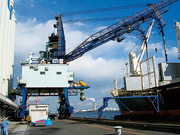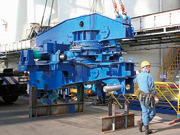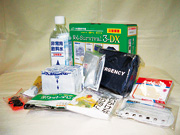- Home
- Sustainability
- Governance
- Risk Management
Risk Management
Basic approach
We have established the Nisshin Seifun Group Risk Management Rules and the Nisshin Seifun Group Crisis Control Rules, and we are strengthening day-to-day risk management to ensure appropriate risk prevention, control, and response.
Business risks
Potential risks in the following areas could impact the Nisshin Seifun Group in various ways, including business results, the stock price, and the Group’s financial position (from the 180th Securities Report).
Main risks
- Developments of international trade negotiations and changes in Wheat Policy
- Product safety
- Disasters, accidents, and epidemics
- Alliances with other companies and realizing the effects of corporate merger and acquisitions
- Raw material procurement
- Information security and digital transformation (DX)
- Environmental issues
- Overseas operations
- Foreign exchange fluctuations
- Securing human resources
- Human rights issues
- Responding to new technologies
We have also formulated the Risk Management Rules, under which we classify environmental risks, social risks, officer and employee risks, legal risks, and other risks as environmental, social, and governance (ESG) risks.
Risk management system
Establishment of the committees
We have established a Risk Management Committee made up of the presidents of our operating companies under the chairmanship of the President of Nisshin Seifun Group Inc. This committee oversees risk management across the entire Group and reports to Group Management Meeting about its activities. Additionally, the Planning Subcommittee, Disaster Subcommittee and Overseas Safety Countermeasures Subcommittee have been established as sub-bodies of the Risk Management Committee. Their role is to consider and propose specific measures relating to issues in their respective areas of responsibility. Specifically, the responsibilities of the Planning Subcommittee include the identification of risks and the assessment of the effectiveness of countermeasures. The Disaster Subcommittee deliberates on measures in response to natural disasters, accidents, and other contingencies, while the Overseas Safety Countermeasures Subcommittee considers measures to ensure the safety of employees and other personnel working for overseas businesses.
Call center establishment
All Nisshin Seifun Group employees have been informed that they are required to report any crisis to a call center established within Nisshin Seifun Group Inc. This information is immediately conveyed to senior executives, who can then implement appropriate initial response measures to minimize damages.
Risk management at overseas operations
One of the rules defined in the Group’s Corporate Code of Conduct calls for the promotion of locally-rooted overseas operations that are in tune with local customs and practices, including rigorous compliance with laws and regulations in each country, based on advice from local attorneys and other experts. We also formulate and apply our own risk management checklists to avoid risks when launching new businesses. Representatives of local subsidiaries use these checklists to verify compliance with local rules, including requirements relating to business licenses and approvals, compliance with minimum wages and other labor-related rules, environmental regulations, health and safety requirements, and the payment of taxes.
We reduce the level of risk at our overseas operations by providing appropriate supervision and support according to local business conditions through the Overseas Safety Countermeasures Subcommittee, a sub-body of the group-level Risk Management Committee. We also use external experts and other resources. In addition, we have established a training system for employees about to be seconded to overseas operations.
Business continuity plan (BCP)
We are working to ensure reliable supplies of safe, dependable food products by enhancing our preparedness for disasters and epidemics under the Group’s business continuity plan (BCP).
Food is essential for the maintenance of human life and also plays a foundational role in healthy, fulfilling lifestyles. We are taking steps to maintain supplies of food products and minimize the impact on consumers in the unlikely event of accidents resulting in casualties or damage to factory equipment. These measures include the establishment of control systems, equipment upgrades, and employee health management.
BCP formulation
A major earthquake or an epidemic caused by new virus would have a significant impact on our business operations. We prepare for such contingencies by formulating a business continuity plan (BCP) to ensure that the Nisshin Seifun Group can continue to fulfill its responsibilities, including the maintenance of social infrastructure relating to food supplies.
Every year we plan and implement BCP-related simulation exercises during BCP enhancement month. The purpose of these activities is to ensure that all staff are prepared to take timely action based on the provisions of the BCP.
Preparations for major earthquakes and other disasters
In 1995, the Great Hanshin earthquake damaged Nisshin Seifun Flour Milling’s Higashinada Plant and the Kobe Plant (closed in 2004). The earthquake caused major damage, including the collapse of embankments due to liquefaction, as well as silo pile fractures and the collapse of the unloader, a suction system used to offload grain from ships.
Drawing on the lessons learned from this disaster, we have implemented liquefaction countermeasures and seismic isolation systems at the Tsurumi Plant, which is Japan’s largest flour mill with a daily capacity of 2,150 tons. In addition, our multi-story automated warehouses at the Fukuoka and Chita Plants, which began operating after the 2011 Great East Japan Earthquake, feature vibration suppression systems designed to limit shaking and prevent rack collapses. Even in the event of a major earthquake, these systems will minimize damage and ensure that we can continue to provide reliable supplies of wheat flour.
Examples of countermeasure
Example 1: Grain unloading equipment retrofitted with seismic isolation systems
The Tsurumi Plant has its own dock with a system that unloads grain from grain carriers. This grain unloader is the first in the world with legs protected by seismic isolation devices.


Example 2: Soil liquefaction countermeasures
Liquefaction triggered by earthquakes occurring directly beneath facilities can cause additional damage, including silo collapses and the destruction of grain unloading docks. We have strengthened seismic countermeasures in docks and carried out ground enhancement work in the surrounding areas to prevent liquefaction.
Example 3: Provision of satellite phones
In the immediate aftermath of a major earthquake, communication with the affected areas by conventional landlines and mobile phones is likely to be difficult due to heavy telephone traffic and damage to lines. We have provided satellite phones to ensure reliable communications between our head office and business sites during the period immediately after a disaster.

Example 4: Stockpiling and distributing emergency food and disaster preparedness kits
We stockpile emergency food at our business sites in readiness for disasters. We also distribute emergency food and disaster preparedness kits directly to our employees, who take responsibility for their storage and management. This approach raises awareness of disasters and reduces the need to distribute supplies in the event of an emergency.
Other risk countermeasure
Improvement of information security
We proactively protect our information assets under a control system based on the Nisshin Seifun Group’s Basic Rules on Information security. We maintain and improve our information security level by issuing alerts to employees and providing education and training. In addition, we are continuously working to strengthen our group-wide information security systems to guard against today’s increasingly complex and sophisticated cyber-attacks.
Protection and use of intellectual property
The entire Nisshin Seifun Group is working together to strengthen its business and R&D activities from an intellectual property perspective. We immediately secure rights over inventions arising and strategically use our intellectual property in ways that contribute to our business activities. We also respect the rights of other parties by taking care to avoid infringements of patents, trademarks, and designs. We carry out investigations and take appropriate action under laws and regulations if we suspect an infringement of the rights of the Nisshin Seifun Group. We combine an offensive approach based on applications for patents to cover our intellectual property rights, with a defensive approach designed to avoid infringements of our rights.
Strengthening governance under a global structure
Every year since 2014 we have held a global forum attended by representatives from all of the Group’s overseas subsidiaries. These events help to strengthen the governance systems needed for our global business activities through the dissemination of Group management policies and discussions about the challenges facing each company.







